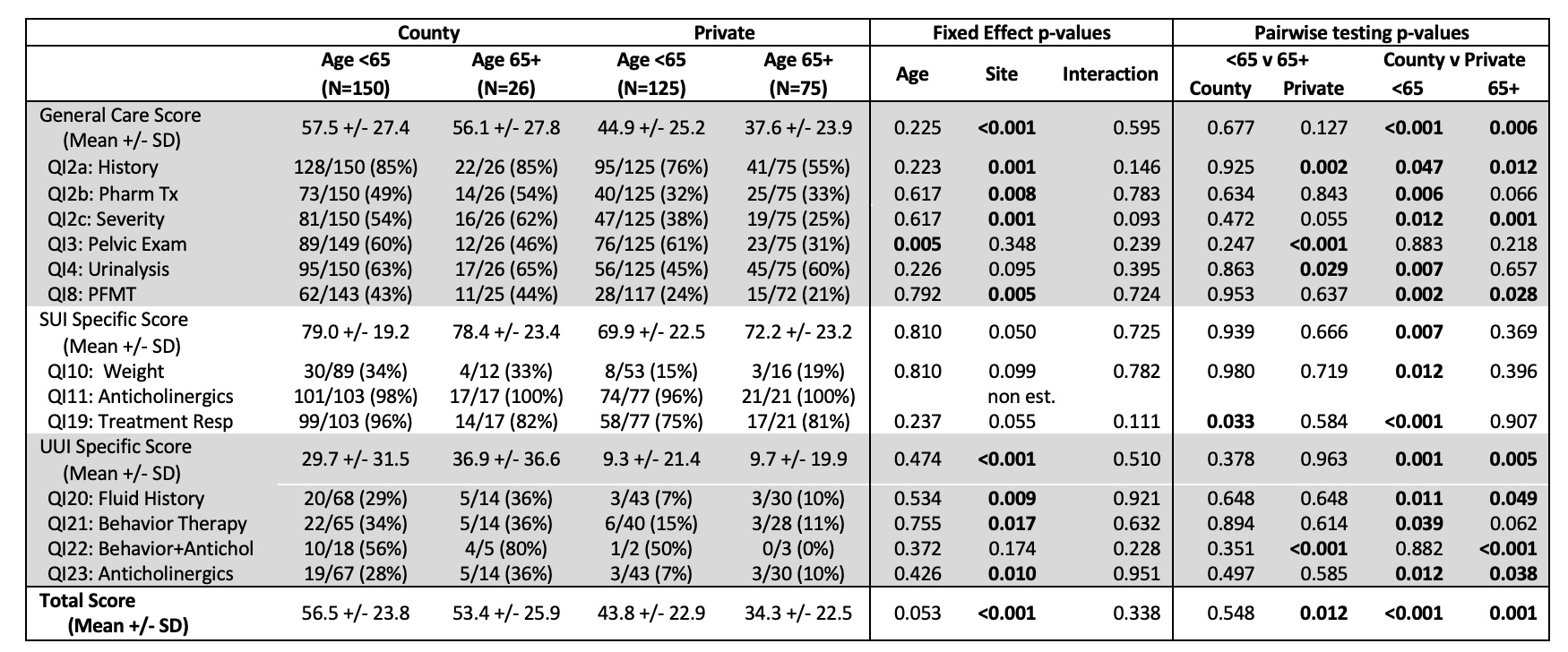Back
Introduction: The overall prevalence of urinary incontinence (UI) increases with age, affecting up to 25% of premenopausal women and 40% of postmenopausal women. Previously, the Assessing Care of Vulnerable Elders-2 (ACOVE-2) study identified disparities among older adults with incontinence. Our objective was to compare the quality of UI care provided to aging heterogeneous population of women in two different clinical settings.
Methods: Medical records from two Los Angeles-based county and two private academic hospitals were reviewed retrospectively. The inclusion criteria required women to be referred to a specialist for new or worsening bothersome UI symptoms. Twelve previously validated UI quality of care indicators (QI) to assess the care provided to women by PCPs 12 months prior to referral to a specialist was used. The QIs included domain-specific metrics for general UI, stress urinary incontinence (SUI), and urge urinary incontinence (UUI). A multivariable analysis of patient age, hospital site, and race/ethnicity was conducted.
Results: A total of 376 patients were identified, of which 53% received care in private hospitals and 47% in county hospitals. 74% of women greater than 65 years of age received care in the private system. When caring for women greater than 65 years of age, PCPs in the private setting were less likely to adhere to UI QIs specific to general UI care, particularly history documentation and performing a pelvic exam. There was low adherence to UUI QIs about behavioral modifications and prescription of anticholinergics. PCPs were more likely to order a urinalysis in the workup of incontinence for older women in the private setting. While there was no significant interaction between age and site, there were differences by site. There was no difference in the overall UI quality of care provided by race after adjusting for age and site.
Conclusions: This analysis demonstrates lower rates of UI QIs adherence by PCPs in the private care system, likely due to the older patient population being seen. The interaction between age and site demonstrated that the site where care is provided matters, and physicians are more likely to implement treatment plans for older women without performing a pelvic exam. Better care in the county system may be explained in part by younger patient age or possibly the use of an electronic referral system for UI. SOURCE OF
Funding: n/a

Moderated Poster Session
Session: MP37: Urodynamics/Lower Urinary Tract Dysfunction/Female Pelvic Medicine: Female Incontinence: Therapy II
MP37-10: Impact of Patient Age On Outcomes Among Women With Urinary Incontinence
Saturday, April 29, 2023
1:00 PM – 3:00 PM CST
Location: S401A

Gabriela Gonzalez, MD, MPH
Resident Physician
UC Davis Urology
Poster Presenter(s)
Introduction: The overall prevalence of urinary incontinence (UI) increases with age, affecting up to 25% of premenopausal women and 40% of postmenopausal women. Previously, the Assessing Care of Vulnerable Elders-2 (ACOVE-2) study identified disparities among older adults with incontinence. Our objective was to compare the quality of UI care provided to aging heterogeneous population of women in two different clinical settings.
Methods: Medical records from two Los Angeles-based county and two private academic hospitals were reviewed retrospectively. The inclusion criteria required women to be referred to a specialist for new or worsening bothersome UI symptoms. Twelve previously validated UI quality of care indicators (QI) to assess the care provided to women by PCPs 12 months prior to referral to a specialist was used. The QIs included domain-specific metrics for general UI, stress urinary incontinence (SUI), and urge urinary incontinence (UUI). A multivariable analysis of patient age, hospital site, and race/ethnicity was conducted.
Results: A total of 376 patients were identified, of which 53% received care in private hospitals and 47% in county hospitals. 74% of women greater than 65 years of age received care in the private system. When caring for women greater than 65 years of age, PCPs in the private setting were less likely to adhere to UI QIs specific to general UI care, particularly history documentation and performing a pelvic exam. There was low adherence to UUI QIs about behavioral modifications and prescription of anticholinergics. PCPs were more likely to order a urinalysis in the workup of incontinence for older women in the private setting. While there was no significant interaction between age and site, there were differences by site. There was no difference in the overall UI quality of care provided by race after adjusting for age and site.
Conclusions: This analysis demonstrates lower rates of UI QIs adherence by PCPs in the private care system, likely due to the older patient population being seen. The interaction between age and site demonstrated that the site where care is provided matters, and physicians are more likely to implement treatment plans for older women without performing a pelvic exam. Better care in the county system may be explained in part by younger patient age or possibly the use of an electronic referral system for UI. SOURCE OF
Funding: n/a

